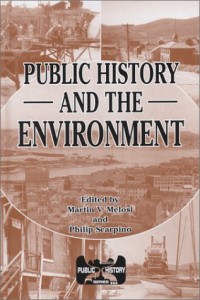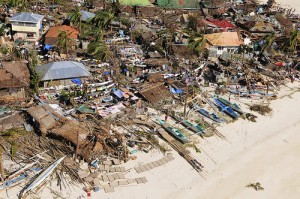Help us build a bibliography on public history and climate change
07 January 2014 – Cathy Stanton
advocacy, digital history, scholarship, sustainability, profession, conference, The Public Historian

In many ways, environmental public history is still a very new field, with just one major title devoted directly to the subject.
Google “public history” and “climate change” and you’ll quickly realize that public historians are only just beginning to talk about how their work relates to the increasingly urgent questions posed by the earth’s rapidly changing climate. You could make a case that environmental public history is itself still in its infancy, even though it’s been more than two decades since Martin Melosi, in his President’s Annual Address to the National Council on Public History, issued a call for “environmental history [to] be a means to make the value of history better understood to the public.”[1] As Melosi pointed out, the combination is a natural one in many ways, yet there are also challenges to pursuing it–for example, the highly political nature of many environmental issues and historians’ caution about crossing the line into advocacy. In the print realm, a single, now-decade-old collection, Public History and the Environment (co-edited by Melosi and Phil Scarpino and published by Krieger in 2004), has been devoted to the subject, and “global warming” makes only two brief appearances in its pages. As the global atmosphere continues to warm and its effects are felt more and more widely, how should public historians respond?
That professional conversation should get a big boost from the National Council on Public History’s spring 2014 conference in Monterey, California, with its theme of “Sustainable Public History,” and we’ll continue to feature posts on the topic here in the weeks leading up to the conference. (If you want to get caught up on what’s been posted so far, have a look at Part 1 and Part 2 of Will Ippen’s summary of our recent survey on public history and environmental sustainability, as well as other pieces with the “sustainability” tag.)

More frequent “superstorms,” like last November’s Typhoon Haiyan in the Philippines, underscore the urgency of facing questions about climate change. Photo credit: Mans Unides
The Public Historian will be publishing a special section on environmental sustainability later this year, and an all-digital publication from the Public History Commons, Public History in a Changing Climate, is scheduled to be available by conference time. As part of that digital project, we’re compiling a bibliography of work that speaks in some way to the intersection of environmental history, public history, and discourse and action around the causes and consequences of climate change. These might be books, articles, “gray literature” (including commissioned studies and unpublished conference papers and proceedings), online resources, or films. They could be from within the fields of history and preservation per se or from outside (for example, from the vast literature on tourism or the worlds of planning and policy).
We’re guessing that most suggestions will be fairly recent, but we’re hoping that some older sources will also let us trace longer threads of engagement. A 1981 article by Mark S. Foster in The Public Historian on automobiles, urban planning, and the end of cheap oil is a case in point. Foster was responding to the oil shocks of the 1970s and posing questions about what historians could contribute to planning processes and how planners and others could avoid falling into ahistorical doomsday scenarios.[2] Anthropogenic climate change wasn’t really on the public horizon at that point, but the discussion is still relevant, and the advice is still good.
You can share your suggestions below in the comments or email them to us directly. Conference-goers will have the first look at the bibliography and the digital collection it will be a part of, but it will be available here in the Commons later in the spring as well.
~ Cathy Stanton is Digital Media Editor for the National Council on Public History.
[1] Martin Melosi, “Public History and the Environment,” The Public Historian 15, no. 4 (Fall 1993): 20.
[2] Mark S. Foster, “The Automobile in the Urban Environment: Planning for an Energy-Short Future,” The Public Historian 3, no. 4 (Autumn, 1981): 23-31.




When you talk about recent works, you’re not kidding! The contributions I am thinking of haven’t even been written or published yet! Here are a couple of things that are on my radar right now:
Last week, the Cultural Landscape Foundation put out a call for articles on landscape and climate change for an upcoming issue of their semi-annual journal, Change Over Time.
The NPS is also in the process of putting out two publications in the next year or so. One is a handbook on climate change impacts to cultural resources, the other is a cultural resources climate change strategy. They have started compiling some case studies here: http://ncptt.nps.gov/articles/climate-change/.
I would also include in the bib cultural landscape works that emphasize change over time and the relationship between nature and culture, such as Preserving Cultural Landscapes in America edited by Alanen and Melnick and Cultural Landscapes: Balancing Nature and Heritage in Preservation Practice edited by Richard Longstreth.
George Wright Society has clued me into some of the debates happening in the science community right now. At the last conference, environmental journalist Emma Marris talked about her book The Rambunctious Garden, which fully embraces the anthropocenic. Philip Cafaro takes NPS to task in his article, “What NPS Should Tell Visitors (and Congress) about Climate Change.” http://www.georgewright.org/293cafaro.pdf.
There may be only one book that expressly connects environmental & public history in the title, but I think the fields are quite closely aligned, as indicated by the fact that NCPH & ASEH have shared annual meetings a few times.
I would encourage you to visit http://niche-canada.org, the website of NiCHE: Network in Canadian History & Environment, a network that bridges environmental and public history (and, full disclosure, a network that I direct!). Some of our projects which bridge public history and climate change specifically include:
http://niche-canada.org/2012/09/26/natures-past-episode-31-histories-of-canadian-environmental-issues-part-1-global-warming/
http://niche-canada.org/research/natures-past-archival-evidence-of-environmental-and-climate-change-exhibit/
http://niche-canada.org/research/canadian-climate-history/historical-climate-change-reconstruction-in-the-great-plains/
http://niche-canada.org/resources/conference-workshop-archive/canadian-climate-history-workshop-2008/
http://niche-canada.org/2013/07/24/swallowed-by-the-seashore/
http://issuu.com/asehtoronto2013/docs/time_flies_poster
And lots more!
Cheers,
Alan
This is wonderful, Alan – thanks for this. I knew of some of the separate NiCHE-related projects but hadn’t really put together all of the impressive work you’re doing!